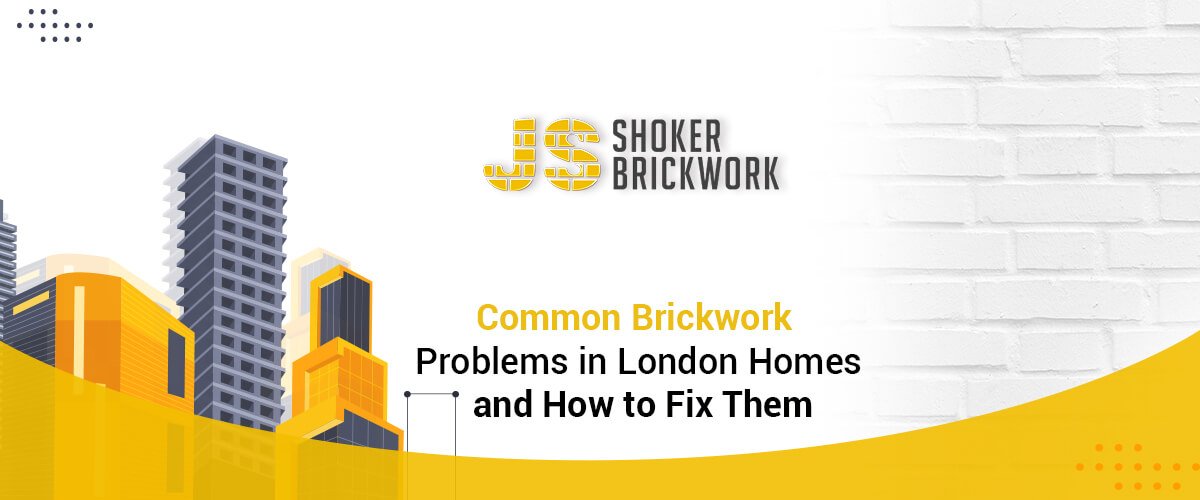Understanding the Causes of Brickwork Problems
Before diving into specific problems and their solutions, it’s essential to understand the underlying causes of brickwork issues. London’s weather, characterized by frequent rain, fluctuating temperatures, and occasional frost, can take a toll on brick structures. Additionally, pollution, poor construction practices, and lack of maintenance can exacerbate these problems. Bricklaying companies in London are well-equipped to address these issues, offering expertise in diagnosing and repairing brickwork problems caused by environmental and structural factors. By working with experienced professionals, you can ensure that your brickwork is properly maintained and repaired, extending its lifespan and preserving its integrity.

Common Brickwork Problems
1. Efflorescence
What is Efflorescence? Efflorescence is the white, powdery deposit that often appears on the surface of bricks. It occurs when water dissolves salts within the bricks or mortar, and as the water evaporates, the salts are left behind on the surface.

How to Fix Efflorescence
- Identify the Source: Determine where the moisture is coming from and address the root cause, such as leaks or poor drainage.
- Cleaning: Efflorescence can often be removed with a stiff brush and water. For more stubborn deposits, use a diluted vinegar solution or a specialized efflorescence cleaner.
- Sealing: Once cleaned, consider applying a water-repellent sealant to the brickwork to prevent future occurrences.
2. Cracking
What Causes Cracking? Cracks in brickwork can result from various factors, including thermal movement, settling of the building, and moisture ingress. In London, temperature fluctuations and frost can exacerbate these issues.
How to Fix Cracks
- Assess the Severity: Small cracks may be cosmetic, but larger cracks could indicate structural issues and require professional assessment.
- Repair Techniques: For minor cracks, use a suitable filler or mortar mix to seal the gaps. For larger or more serious cracks, professional intervention may be necessary, including techniques such as repointing or installing helical bars for reinforcement.
- Preventative Measures: Ensure proper drainage around the foundation and use flexible sealants that can accommodate thermal movement.
3. Spalling
What is Spalling? Spalling occurs when the surface of the brick flakes or peels away. This is often due to water infiltration and subsequent freeze-thaw cycles, which cause the brick to expand and contract, leading to surface damage.
How to Fix Spalling
- Remove Damaged Bricks: Carefully remove the spalled bricks and replace them with new or reclaimed bricks that match the existing ones. Reclaimed bricks are an eco-friendly option that provides both durability and historical character.
- Improve Drainage: Ensure that gutters and downspouts are functioning properly to direct water away from the brickwork.
- Apply Sealant: Consider applying a breathable water-repellent sealant to protect the brickwork from moisture.
4. Mortar Deterioration
What Causes Mortar Deterioration? Over time, mortar joints can deteriorate due to weathering, water infiltration, and pollution. Deteriorated mortar can lead to weakened structural integrity and increased moisture ingress.
How to Fix Mortar Deterioration
- Repointing: Repointing involves removing the damaged mortar to a suitable depth and replacing it with fresh mortar. Ensure the new mortar matches the original in composition and color.
- Regular Maintenance: Regularly inspect and maintain mortar joints to prevent extensive deterioration. Address minor issues promptly to avoid costly repairs later.
5. Damp Penetration
What is Damp Penetration? Damp penetration occurs when moisture infiltrates the brickwork, leading to damp patches on interior walls, mold growth, and structural damage.
How to Fix Damp Penetration
- Identify the Source: Determine the source of the moisture, which could be due to leaks, rising damp, or poor drainage.
- Repair Leaks: Fix any leaks in the roof, gutters, or plumbing that may be contributing to damp issues.
- Damp-Proofing: Consider installing a damp-proof course (DPC) to prevent rising damp and use breathable materials for repairs to allow moisture to escape.
- Ventilation: Improve ventilation in the affected areas to reduce condensation and moisture buildup.

Preventative Measures for Long-Term Brickwork Health
- Regular Inspections: Conduct regular inspections of your brickwork to identify potential issues early. Look for signs of cracking, spalling, efflorescence, and damp penetration. Early detection can help prevent minor problems from becoming major repairs.
- Proper Drainage: Ensure that your home’s drainage system is functioning properly. Gutters, downspouts, and drainage channels should be kept clear of debris and directed away from the brickwork to prevent water infiltration.
- Quality Repairs: When repairs are needed, ensure that they are done using high-quality materials and techniques. Poor repairs can lead to further issues down the line. Hiring a professional with experience in brickwork repairs can ensure the job is done correctly.
- Protective Treatments: Applying breathable water-repellent sealants to your brickwork can provide an extra layer of protection against moisture. However, it is important to use products specifically designed for brick to avoid trapping moisture inside.
Conclusion
Maintaining the brickwork of your London home is essential for preserving its structural integrity and aesthetic appeal. By understanding common brickwork problems and implementing effective solutions, homeowners can protect their properties from the harsh weather conditions and environmental factors unique to London. Regular inspections, proper repairs, and preventative measures will ensure that your brickwork remains in excellent condition for years to come.
Have any questions or need more information? Contact us today on the details below, and we’ll be happy to assist you!
Website: JS Shoker Brickwork
Phone: +44-7403201624
Email: info@jsshokerbrickwork.co.uk



